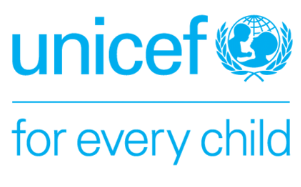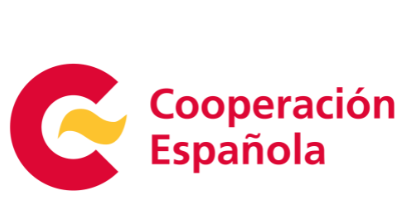
Briefs
.
November 17, 2025
Unlocking Diaspora Capital for Sustainable Growth: Lesotho’s Potential Path to a Sovereign Sustainable Diaspora Bond
Télécharger le document
Access resource
Lesotho is exploring an innovative financing solution to channeldiaspora savings into productive, green, and social investments. Withsubstantial diaspora capital, supportive policy frameworks, manageable fiscalconditions, and access to a mature neighboring capital market in South Africa,the country has the potential to pioneer a sovereign sustainable diaspora bond—settinga precedent for how smaller economies can mobilize diaspora resources forsustainable development and inclusive growth.
1. Mobilizing diaspora capital for Africa’s development: fromtraditional diaspora bonds to sustainable diaspora bonds
Sub-Saharan Africa holds significant potential indiaspora finance, with remittance flows (as an underestimated proxy of diasporacapital) comparable in scale to foreign direct investment (FDI) and officialdevelopment assistance (ODA). Remittances from the African diaspora have grownsteadily in the last two decades and have become one of the most importantexternal financial inflows to the African continent. In recent years, annualremittance inflows to Sub-Saharan Africa reached above$50 billion, catching up with and even outpacing ODA and FDI inflows (Figure 1).This is also why the second10-year implementation plan (2024-2033) for the AU Agenda 2063 highlights diasporaremittances as one of the critical financing sources for mobilization byAfrican countries.
While diaspora funds have primarily supportedhousehold consumption, their broader potential to drive sustainable developmentthrough productive investment remains largely untapped. This is often hinderedby the absence of credible, structured financing instruments and collectivemechanisms to channel diaspora capital into investable development projects inAfrican countries.
Diaspora bonds are gaining traction among African countriesas one of the diaspora finance instruments to achieve greater developmentimpacts. For instance, Nigeria's 2017 sovereign diaspora bond, issued inLondon, successfully raised $300 million (130% over-subscribed) for financingbudgeted capital expenditures and was redeemed in 2022. However, scaling suchsuccesses remains a challenge, particularly hindered by trust deficits ingovernment institutions, as evidenced by Ethiopia's prior experiences. Beyond institutionaland political trust factors, other challenges—such as macroeconomic volatility,remittance transfer bottlenecks, and employment insecurity among segments ofdiaspora populations—can also constrain participation of diaspora finance, underscoringthe need for diaspora bonds to be complemented by other sources of developmentfinance.
To boost investor confidence and participation,integrating sustainability into diaspora bonds (i.e., sustainable diaspora bondissuance) presents a viable evolution and solution. By aligning diaspora bondstructures with growth-enhancing climate, environmental and social impact goalsand by embedding transparency, governance, accountability, and impact reportingmechanisms, governments as sovereign issuers can improve credibility andbroaden appeal to both diaspora and institutional investors. CaboVerde'srecent issuance of blue and green bonds, though issued by corporate actors, providesencouraging evidence: 25–35% of subscriptions came from country’s diasporacommunities, showing a growing appetite from diaspora investors for sustainableinvestment tied to meaningful development outcomes.
Where else in Africa could a sustainable diaspora bondtake shape and truly demonstrate its potential?
One promising answer may lie in the Lesotho–SouthAfrica diaspora finance corridor—one of the continent’s most concentrated anddynamic channels of diaspora capital—where a sovereign sustainable diasporabond could help channel savings from Lesotho’s diaspora in South Africa intoproductive, green, and social investments back home.
Figure 1. Growing diaspora capital/remittances to Sub-Saharan Africa
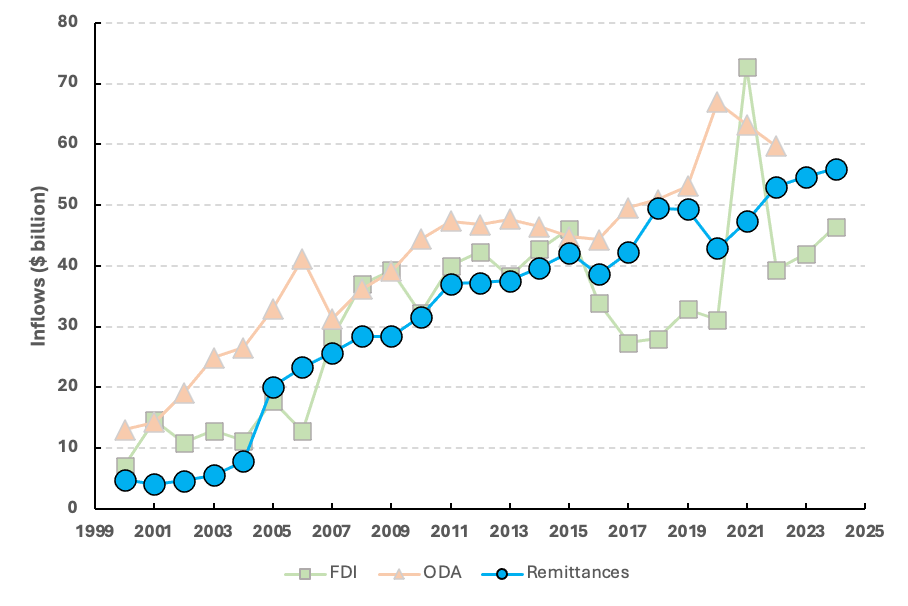
2. Lesotho’s potential for a sovereign sustainablediaspora bond: key feasibility factors for issuance in South Africa
The potential issuance ofLesotho’s sovereign sustainable diaspora bond in South Africa’s capitalmarket offers an opportunity to mobilize medium- to long-term capital from boththe Lesotho diaspora and institutional investors to finance nationaldevelopment priorities. Such an issuance could build on Lesotho’s uniquediaspora concentration in South Africa, strong domestic policy frameworks fordiaspora bond, available fiscal space, South Africa’s mature capital market,and the growing investor appetite for sustainability-oriented finance instrumentsto create a credible and scalable model for channeling diaspora resourcestoward national sustainable development.
2.1 Strong diaspora capitalpotential and contribution willingness:
Over 95% of Lesotho’s diaspora live and work in SouthAfrica, contributing about 95% of Lesotho’s diaspora capital (proxied byremittances inflows) and highlighting the strong socio-economic ties betweenthe two countries (Figure 2a). Remittances from the diaspora contributeapproximately $500 million annually, accounting for nearly 22% of Lesotho’sGDP, an important economic inflow to Lesotho (Figure 2b). The diaspora hasexpressed a strong willingness to contribute to national development, asreflected in Lesotho’sNational Diaspora Policy, butcurrently lacks formal and effective investment mechanisms, such as a trustworthybond instrument.
2.2 Supportive national strategiesfor a sustainable diaspora bond:
The issuance of a diaspora bond is explicitlyprioritized in key national strategic frameworks, including the NationalStrategic Development Plan (NSDP) II 2023/24-2027/28, the IntegratedNational Financing Strategy, and the Lesotho National Development Corporation(LNDC) DiasporaEngagement Strategy for Trade and Investment 2020-2025. NSDP II prioritizes growth-enhancing publicinvestment in key sustainable development sectors such as renewable energy,agriculture, manufacturing, infrastructure, water, waste management, ICT,ecotourism, health, education, and affordable housing, well-aligned with the underlyinggreen and social project categories of internationalsustainable bond principles. Forexample, the government will invest M1.5billion (about$86 million) for renewable energy-focused energy infrastructure development andupgrades in the 2025/26 financial year to power economic activities and advancesustainable development goals. The government will also implement initiativesunder the Investment Climate Action Plan to stimulate private investment andjob creation, including digitalizing government-to-business services,streamlining business registration and licensing processes, and strengtheningfinancial infrastructure to enhance private sector access to capital, amongother measures.
2.3 Feasible fiscal and reserve space for adiaspora bond:
Lesotho has seen a strong rise in total governmentrevenue in recent years (Figure 2c), from around 45% to over 60% of GDP, drivenby improved domestic revenue and Southern African Customs Union (SACU) transfers(30–40% of total revenue). A notable fiscalsurplus of10.6% of GDP was achieved in 2024/25, and fiscal surpluses are expected tocontinue over the medium term for the next three years. Publicdebt hasstabilized, easing to below 60% of GDP, while external debt servicing averagesjust 6% of revenue (Figure 2d). Lesotho’s foreignreserves havestrengthened steadily, rising from 3.3 to 5.5 months of import cover between2017 and 2024, approaching a comfortable level, with the nominal value risingfrom $0.66 billion to $1.01 billion. FitchRatings hasaffirmed Lesotho’s sovereign credit rating at B with a stable outlook,indicating a manageable fiscal environment for new instruments like diasporabonds.
2.4 Favorable marketreadiness in South Africa for ZAR-denominated issuance:
South Africa’s capital market is mature and active insovereign and sustainable bond issuances, while Lesotho’s capital market isstill nascent. As the Lesotho Loti is pegged to the South African Rand, issuinga Rand-denominated bond would avoid foreign exchange risk for the government.And the bond with local currency financial returns would offer diasporainvestors an efficient investment alternative to remittances, which currently bearan average 11% transfer cost, while ensuring they see thetransparent use of bond proceeds for sustainable national development.
Figure 2. Lesotho’s diaspora finance landscape and fiscal space
a. Lesotho diaspora population and capital distribution
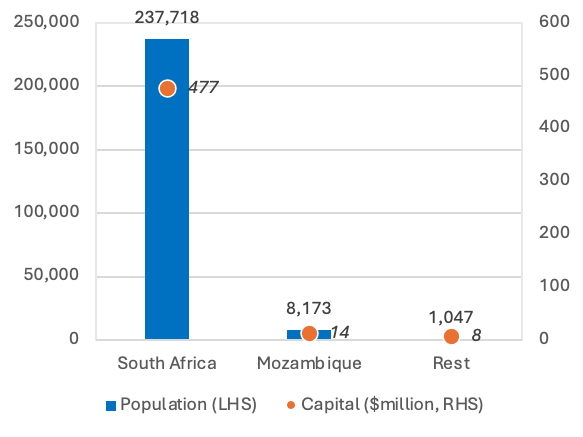
b. Lesotho’s remittances

c. Lesotho’s government revenue (% of GDP)

d. Lesotho’s public debt

Source: RemitSCOPE, UN DESA, World Bank and IMF.
3. Potential benefits and strategic value of asustainable diaspora bond issuance
Given these enabling conditions, Lesotho is wellpositioned to realize multiple strategic benefits through the potential issuanceof a sovereign sustainable diaspora bond.
· Mobilizenew and diversified sources of financing
The bond would expand Lesotho’s publicfinancing options by mobilizing medium- to long-term capital from both the Lesothodiaspora and regional institutional investors. It would help diversify theinvestor base beyond traditional development partners and concessionalborrowing, bringing new, market-based resources into the economy.
· Strengthengovernment credibility and investor confidence
A transparent and well-structuredsustainable diaspora bond would enhance confidence among both diaspora andinstitutional investors in the Government of Lesotho’s fiscal and national developmentmanagement. A successful issuance would elevate Lesotho’s visibility in theregional sustainable bond market and demonstrate the government’s growingpolicy maturity and commitment to responsible debt management.
· Empowerthe diaspora as partners in national sustainable development
The instrument would provide the Lesothodiaspora with a credible, impact-aligned investment channel to contribute tosustainable development at home while earning financial returns. By linkinginvestment to tangible, growth-enhancing green and social outcomes, the bondcan deepen both the financial and social engagement of the diaspora inLesotho’s sustainable development.
· Improvethe quality and efficiency of public investment
By embedding strong governance, traceableproceeds management, and transparent reporting, the bond can serve as adiscipline tool to strengthen the government’s capital spending efficiency. Itwould also help reinforce project preparation and appraisal capacity, enhanceinter-ministerial coordination, and improve the timeliness of impact reporting,which are key areas identified for improvement in Lesotho’s public investmentmanagement.
· Buildinstitutional and market foundations for the future
A successful inaugural issuance wouldestablish an exemplary model in the regional sustainable finance market and laya solid foundation for further domestic capital market development in Lesotho.Lessons from this debut could inform future green, social, and sustainabilitybond issuances, helping institutionalize capacity and attract more long-terminvestors to the country’s national development priorities.
4. Potential bond structure and preliminary designconsiderations
Figure 3. Illustrative bond structure for Lesotho’s potential issuance
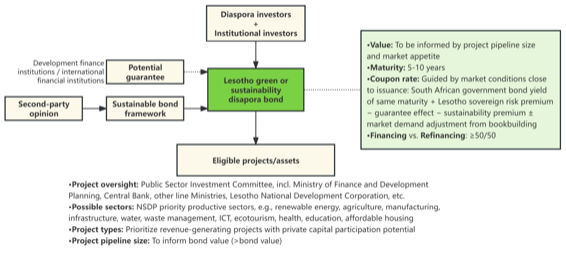
Preliminary analysis suggests that Lesotho couldtarget an inaugural issuance on the order of tens of millions of US-dollarequivalent (around $50 million), sufficient to test market appetite among bothdiaspora and institutional investors and to demonstrate the viability of asustainable diaspora bond model. An illustrative bond structure is outlined inFigure 3, informed by a pre-feasibility assessment (see Figure 4 for theunderlying analytical framework).
Figure 4. Analytical framework for Lesotho's sovereign sustainable diaspora bond issuance

Source: Authors’ adaptation from OECD.
5. Key steps for the potential bond issuance
The key steps for the potential issuance of Lesotho’ssovereign sustainable diaspora bond in South Africa are outlined below (Figure 5):
· Step1: Conduct a feasibility study and marketassessment.
Conducta comprehensive study to evaluate the technical, regulatory, financial, andmarket viability of issuing a sustainable diaspora bond. This includes demandanalysis among the diaspora in South Africa, investor appetite for sustainablebonds, comparative pricing, risk assessment, and alignment with both Lesotho’sand South Africa’s macroeconomic and regulatory environments. Regulatoryauthorities in Lesotho and South Africa will be engaged to clarify requirementsand approvals needed for a cross-border sovereign sustainable diaspora bondissuance. These include, for example, the Ministry of Finance and DevelopmentPlanning of Lesotho, Central Bank of Lesotho, Maseru Securities Market ofLesotho, Ministry of Foreign Affairs and International Relations of Lesotho,Johannesburg Stock Exchange of South Africa, Financial Sector Conduct Authorityof South Africa, National Treasury of South Africa, and South African ReserveBank. The study will conclude with a technical roadmap detailing the key nextsteps in the bond issuance process.
· Step2: Identify preliminary eligible projects for the bond proceeds usage.
Through theinter-ministerial Public Sector Investment Committee, assess and identify acredible preliminary pipeline of eligible green, social, or sustainableprojects and capital expenditures aligned with NSDP priorities and budget plansto anchor the use of proceeds of the bond. Key productive sectors, particularlythose that are structurally underinvested, may include renewable energy,agriculture, manufacturing, infrastructure, water, waste management, ICT,ecotourism, health, education, and affordable housing. Revenue-generatingpublic investment projects that have high potential to attract private capitalparticipation can be prioritized.
· Step3: Develop a sustainable bond framework together with an external review.
Develop arobust sustainable bond framework aligned with ICMA’s Green, Social, orSustainability Bond Principles. The bond framework will define four key pillars:(1) use of proceeds – what types of green and social projects will befinanced and through what forms of public expenditure, such as direct capital investment,project operating expenses, fiscal transfers, or tax subsidies; (2) processfor project evaluation and selection – what will be the governancestructure and process for assessing and selecting eligible projects; (3) managementof proceeds – how the raised funds will be managed and tracked, for examplethrough a dedicated account or earmarked system; and (4) allocation andimpact reporting – how the government will disclose the audited allocationof proceeds and the resulting environmental and social impacts using clearindicators and, where applicable, independent verification. An independent externalreview via a Second-Party Opinion will be obtained for the bond framework toenhance the bond’s credibility and investor appeal.
· Step4: Launch marketing and engagement campaign with diaspora and institutionalinvestors.
Roll outa strategic communications and outreach campaign targeting the Lesotho diasporaand institutional investors in South Africa at key milestones, including thephases of feasibility study, bond framework development, and final-stageinvestor roadshows. Leverage digital platforms,diaspora associations, and investor roadshows to strengthen the diaspora’sfinancial literacy and clearly communicate the bond’s sustainability focus,return structure, and development impact, with informational materials translatedinto major languages spoken by the Lesotho diaspora where feasible. Inparallel, explore potential bond guarantee arrangements with developmentfinance or international financial institutions, based on cost–benefit analyses,to further enhance investor confidence.
· Step5: Structure, price, and issue a sovereign sustainable diaspora bond.
Work withappointed lead arrangers, legal advisors, and underwriters to finalize the bondstructure (value, maturity, coupon rate, unit of issue, minimum subscription, financingand refinancing shares, allocation schedule, payment schedule, etc.), bond tradabilityon secondary markets and distribution options, and issue the bond through theJohannesburg Stock Exchange of South Africa in an investor-accessible process.
Figure 5. Key steps for the potential bond issuance

The Government of Lesotho, with support from UNDP, is currentlyseeking a highly qualified consultancy firm, preferably an investment bank withproven experience in sovereign and sustainable bond issuance in Africa, toconduct a detailed feasibilitystudy forthe potential issuance of a sovereign sustainable diaspora bond. In parallel, thebond concept was recently presented at the Lesotho DiasporaTrade and Investment Forum 2025, held inOctober in South Africa, where it received strong interest and positivefeedback from Lesotho diaspora participants.








